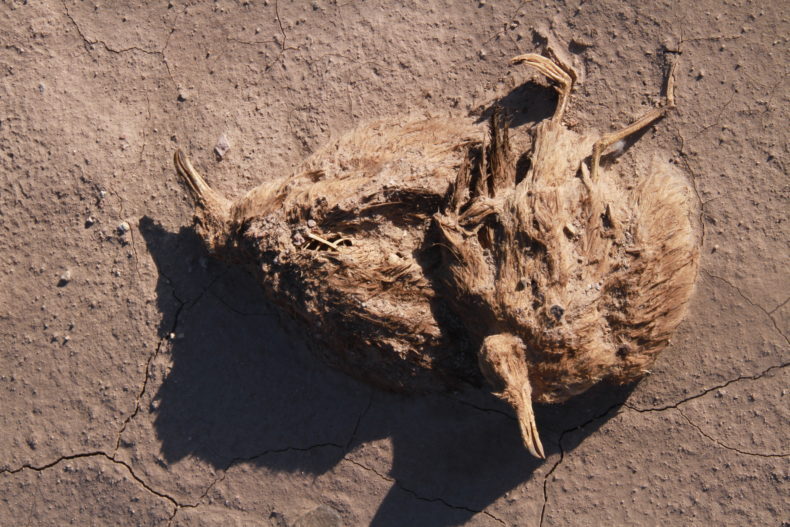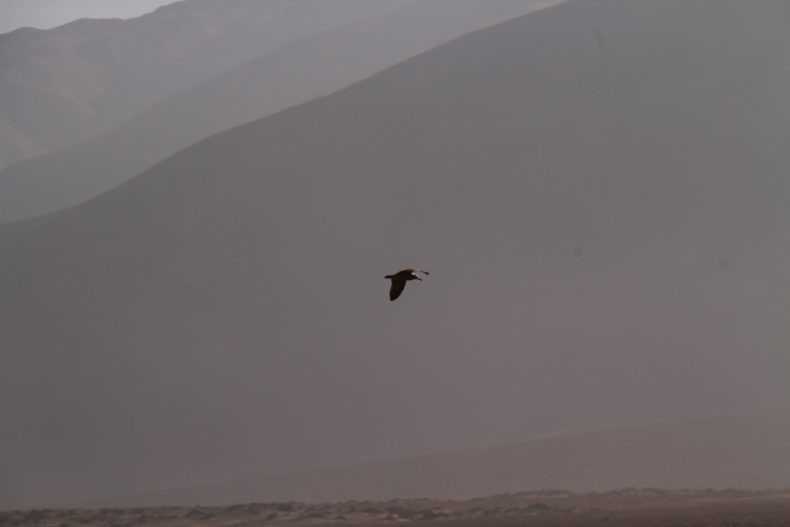
This post originally appeared May 3, 2018
The Atacama Desert is country that wears quiet like a skin. Stretching through the top 600 miles of Chile, it is so spare of all save earth and rock that it calls to mind bone stripped of flesh by sun, wind, teeth. It is a place that makes you understand why the painter Georgia O’Keeffe saw in pelvises and skulls the curves of desert hills. But the Atacama is more naked still than the Southwestern deserts she loved. “When you think of desert, probably you think of Sonora or Chihuahua,” a Chilean biologist recently told me—the vast, brutal deserts of northern Mexico. “They are forests compared to Atacama.”
Pause and listen for a moment: Where does the sound you hear arise? In most places, it comes from life and water. Voices and the growl of cars. The burble of rain and rivers. The rustle of leaves. In the Atacama, what sound there is comes from wind. What life there is goes underground: Spiders lizards birds, finding homes in the cool dark of holes. When Rudulfo Amando Philippi, a German naturalist, made a famous expedition across this desert in the mid-19th century, he improvised by sheltering in the shadow of his mule.
But at night, the Atacama does have a song, and it comes from the sea to the west, on the other side of the mountains. The first time I heard it, on a two-week expedition, I was up later than my five companions, laying alone on a fin of earth, trying to make sense of the Southern Hemisphere Milky Way. I thought the sound was a fox, because it was series of three weird barks, descending, somewhere on the western horizon. When it came again the next night, a single hoarse call and closer now, it was clearly a bird. One call, then nothing more, as if the world had been silenced by the fog rolling in. But soon, deeper in the desert, the call came each night in stuttering flocks of sound at two or three in the morning.
Somewhere behind the darkness there were little knots of gray gulls, in transit with fish they had caught in the Pacific, headed for nests 90 kilometers deep in the realm of sand and stone.
Garumas, as local people know them, are beautiful gray birds with white heads, liquid black eyes and dark bills. They are nocturnal over land. They cry out as they go—weird, disembodied laughter from the star-strewn sky. On our last days in the desert, we decided to take a side trip for a few hours to try and find them. Over the hills we went in dusty trucks, then bumped across a railroad track and veered into a wash. A short way on, we passed an abandoned looking train station, its flanks piled with broken ties, thirteen sulfuric acid cars parked in the nothing. We turned away from a black mountain and drove towards a pink one, catching the gaze of late afternoon sun, pushing forward on the dark, straight paths of our long shadows.
Patrich, at the wheel, paused to peer out the driver’s side window at a strange hubcap-looking thing with a flag protruding. “I think that’s a landmine,” he said casually, before steering on. Several washes farther, we crunched to a stop on a broad flat.
In 2015, Fernando had told us on the drive, this place was home to garumas in all stages of life, spreading as far as the eye could see: adults tending nests of scraped earth, speckled eggs on the hard ground, speckled chicks tucked into the shade of basketball sized rocks. No self-respecting bird lover could pass near without trying to see it, without trying to hear it: it was like the desert’s own throat, singing, barking, calling, a voice wheeling on thousands of graceful wings.
But stepping into the waning day, the only desert voices we heard were the ones we had already grown accustomed to: The wind, the silence.
“Fuck,” Fernando said, his hair blowing over his eyes. “I think they have abandoned this colony.” He shoved his hands into is pockets and hunched away, peering at the ground. The rest of us fanned out too. Empty nests. Rocks streaked white with guano. And soon, mummies: Hundreds of them. Parts of anchovies and birds, heads and feet and whole adults and palm sized chicks, scattered among the stones, littering the bottom of wide runnels carved through the earth. There had been rare, catastrophic rains in some intervening year, a flood that clawed through the colony, that sent the birds to sing elsewhere.
Now this was a still place, populated only with the memory of water: The flood that killed, the ocean that fed. I bent to peer into the orbits of a thumb-sized skull. I imagined it like a shell: Put it to your ear to hear a breathing sound of sea. Distant surf, its incessant cycle of curl, crash, repeat, and farther out, the restless commotion of the swell–all of it held inside this small bundle of featherweight bones and sinew.

Photos courtesy of the author.